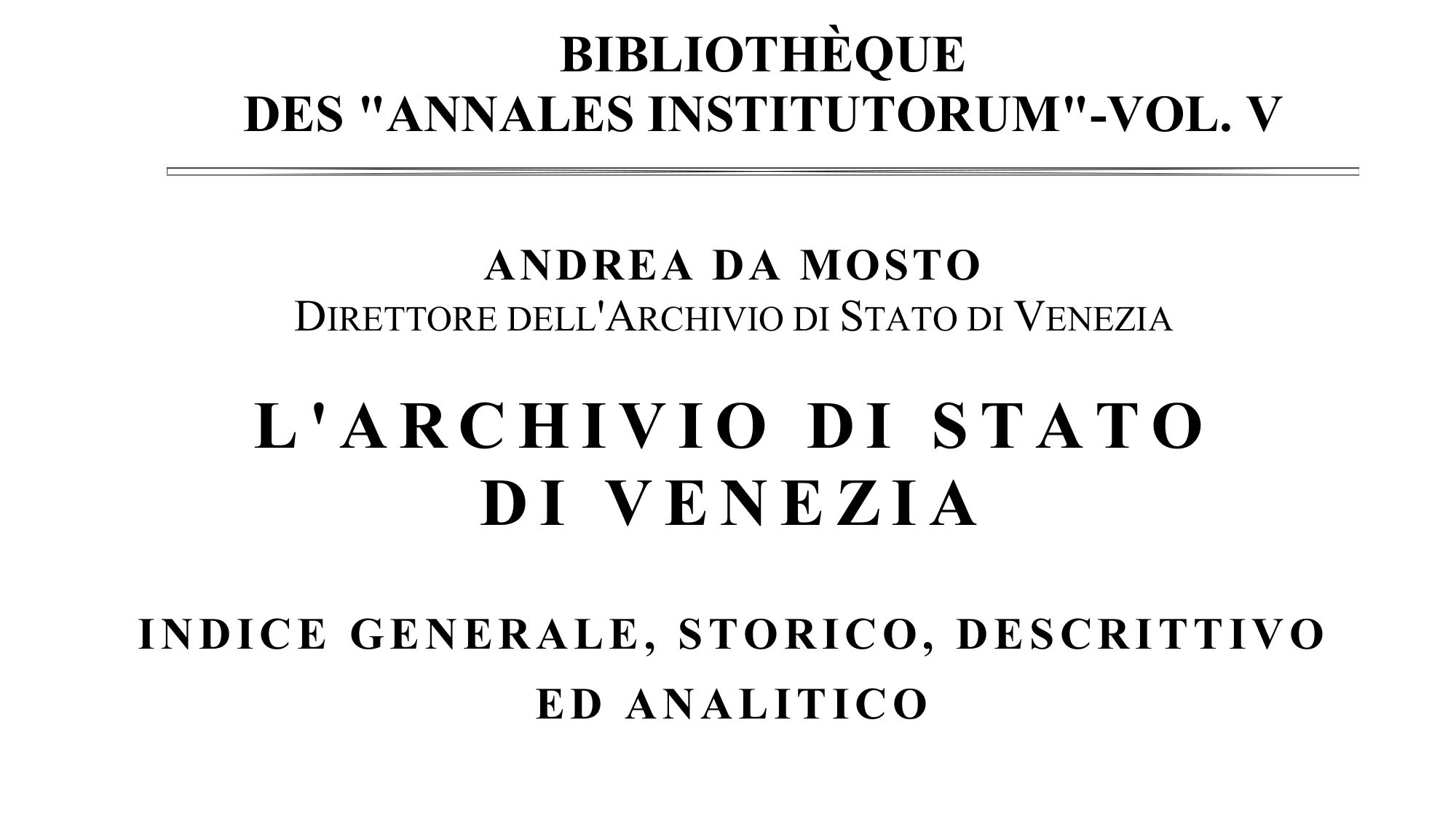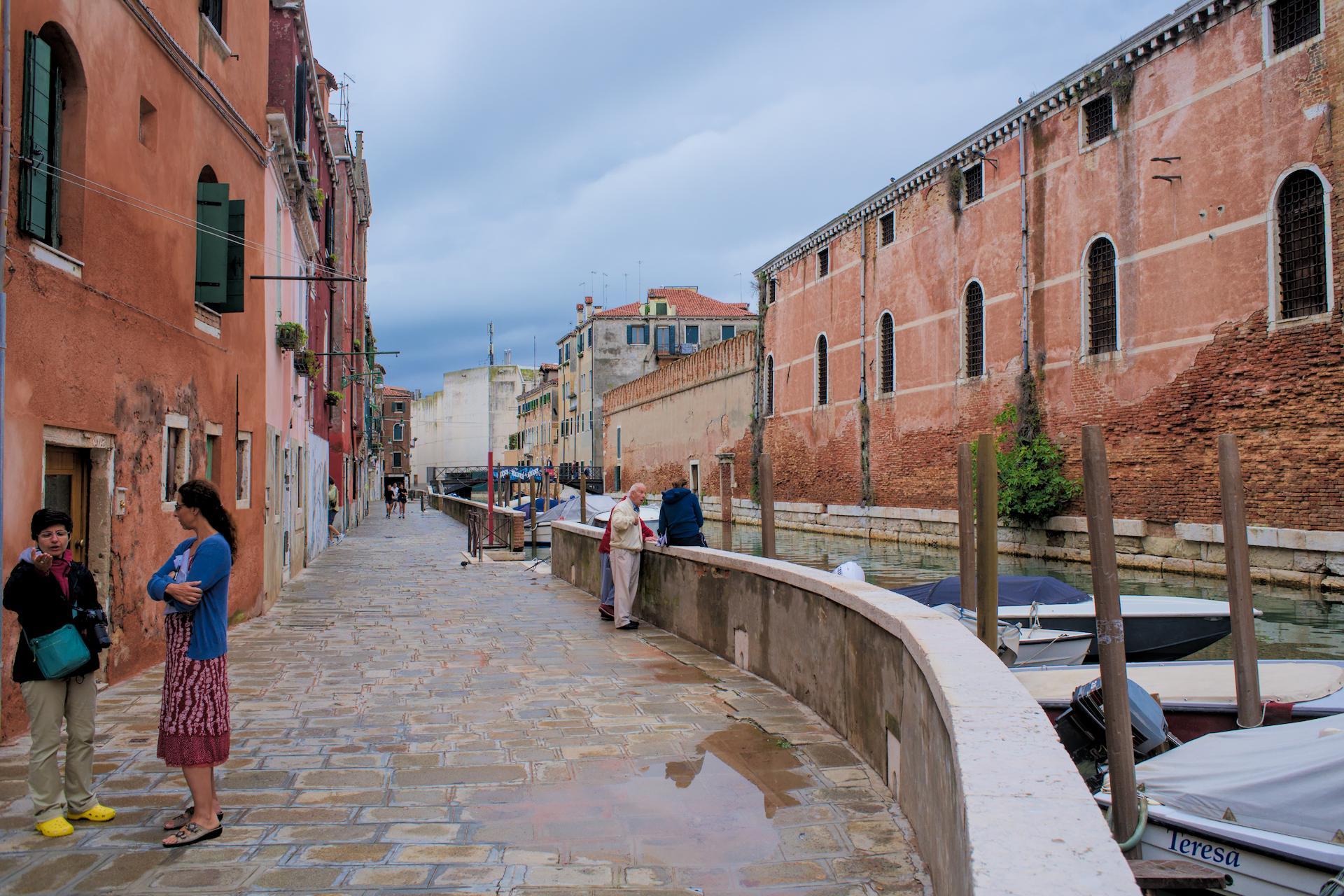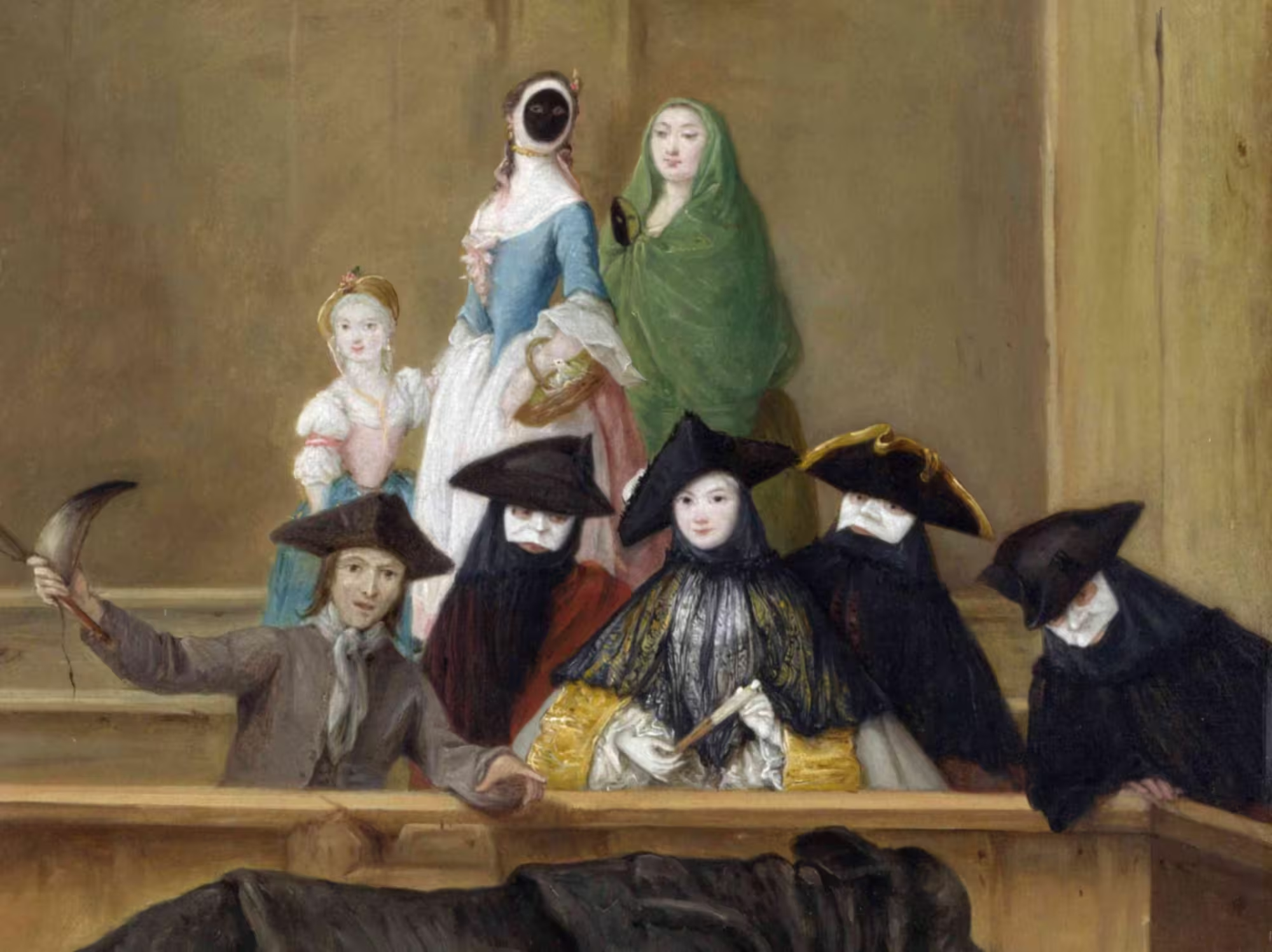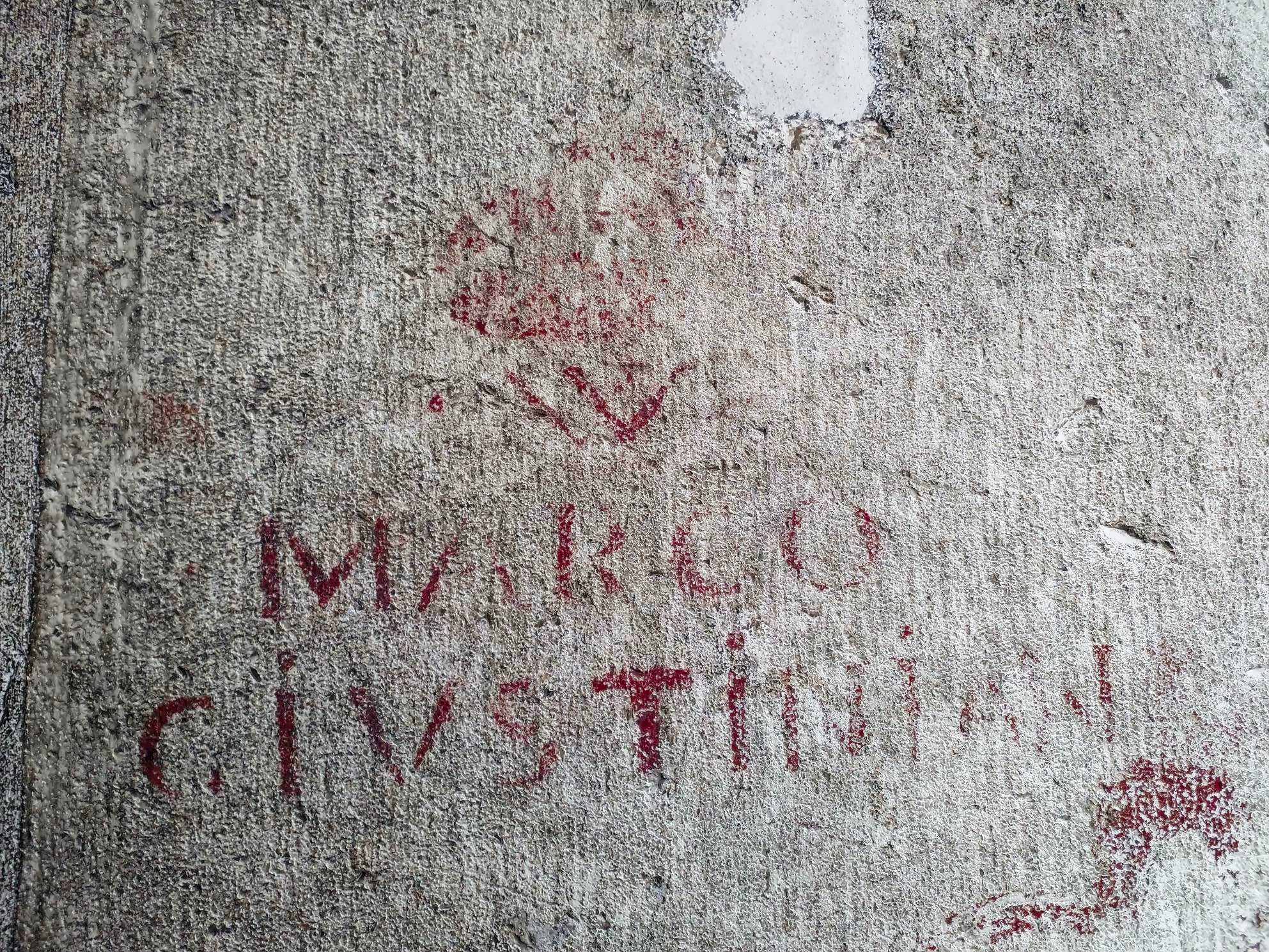Pien Collegio
The L’Archivio di Stato di Venezia: indice generale, storico, descrittivo ed analitico by Andrea Da Mosto was published in 1937. Besides being a general index of the holdings of Venetian documents in the state archive, it contains short historical descriptions of most Venetian offices and magistracies.
Andrea Da Mosto (1868-1960) was director of the Archivio di Stato di Venezia (1936-1937).
It was the custom of all the governing bodies of the Republic, on the occasion of important affairs, to create within themselves or add special commissions destined to study or take care of the affairs themselves; their members used to call themselves «Savi» (Sapientes).1
Some of these commissions or adjuncts (zonte;2 additiones), either due to the continuity of the circumstances due to which they had been established, or for other reasons, became permanent. Such were those who, aggregated to the Serenissima Signoria,3 constituted the Collegio.
Savi del Consiglio — Sages of the Council.
The Savi Grandi or Savi del Consiglio dei Pregadi became a permanent body around 1380; their number, varying in the early days, was later definitively fixed at six. Their term in office was six months, but they were changed three at a time, so that the new ones would be instructed by the old ones in the matters of the Saviato.4 They took turns in their office every week, and the Sage on duty was therefore called “di settimana”.5 Their functions were very broad; they had to provide, as a decree of 27 March 1396 says, «omnibus et singulis spectantibus et relevantbus consilio rogatorum ac dependentibus et connexis ab eis».6 This was construed both as the execution of the resolutions of the Pregadi and – and even more – as the preliminary planning of the affairs to be decided in the Senate. Only the most considered and esteemed patricians were called to this very high office.7
Savi di Terra Ferma — Sages of the Mainland.
A decree of 1420 tells us about the Sages of the Mainland, and they probably derived from those Savi elected extraordinary for the war in 1412. There were five of them, and they were elected by the Pregadi, partially, like the Savi Grandi, at the end of each semester in office: alternately three and two. They were aggregated to the Senate in 1432. For the special tasks that were assigned to them see: Savio alla Scrittura, Savio alle Ordinanze, Savio Cassier. Of the remaining two, one oversaw the Ceremonials and the other of the sending of the da mo.8
Savi agli ordini.
There is a certain trace of the Savi agli ordini in the College only in 1402. They were aggregated to the Senate in 1442. There were five of them, and they were elected like the Sages of the Mainland. But it was not necessary for them to be part of the Senate, as tradition had established for the members of the other two branches. In the early days they were entrusted with the maritime activity of the Republic and the care of the affairs of the Sea Dominion, but then the saviato agli ordini became a sort of training ground for introducing the young patricians to the governance of public affairs. They had no deliberative vote in the assemblies.
The three branches of Savi, united and presided over by the Signoria, formed the Pien Collegio, which had its own competences. First of all, the pre-consultative activity of the various Saviati, as well as individually, was carried out above all in the College. Normally, the decrees to be proposed in the Pregadi were subjected to prior discussion by the Collegio. The competent Savi, however, were not obliged to follow its opinion.
It had few deliberative powers: it could not dispose of sums exceeding 25 ducats; and it could only grant pardons within this limit. It had broader powers in relations with the Church because the examination of the relevant documents was referred to the Pien Collegio, assisted in this zealous task by the Consultori in Iure.9
In the judicial field it had to resolve disputes that arose regarding ecclesiastical benefits and patronages, those regarding the privileges of subject cities, and those regarding duties and tax contracts. But the latter together with other organs.
It served as courier for public letters, ducal letters and state decrees.
An increase in the importance of the College occurred in 1526, when it was given the power, albeit under certain formalities, not to communicate to the Senate acts that it deemed appropriate to keep secret (unread communications); a power, which together with the other to issue decrees during the holidays of the Senate (decrees mandantibus sapientibus) and that of suspending the execution of the decrees of the Pregadi itself, with the obligation to justify the reasons in the following session, made the Collegio, especially in the 1700s, in a certain way the arbiter of the politics of the Republic.
The Collegio received the ambassadors of foreign states, the nuncios of the subject cities and the bishops and prelates, both from subject cities for the affairs of their dioceses, and foreigners when they came to Venice for reasons of their office.
Translator’s notes
- Sages, but since this is a formal title, I have left the Venetian word. ↩︎
- In the Venetian state, the word zonta, which means adjunct, was often used for positions added later to an existing office of state. ↩︎
- The Council of the Doge, consisting of six councillors. The Doge and his advisors generally presided over the main institutions of the state. ↩︎
- The Saviato is the office of the Sages, so a “Sageship” in English? ↩︎
- Literally, “of the week.” ↩︎
- Roughly: Every and one issue of the Senate’s competence, or relevant to it, or dependent on or connected to it. ↩︎
- The Pregadi, Rogati and Senato are all different names for the same institution. ↩︎
- The da mo — which literally means “from now” — were decrees and deliberations which entered into force immediate when deliberated. ↩︎
- The Consultori in Jure were advisors to the government in theological matters and relations to the Papal curia. ↩︎
Original Italian text
Pien Collegio
Era costume di tutti i corpi governanti della Repubblica, in occasione di affari importanti, creare nel proprio seno od aggiungersi commissioni speciali destinate a studiare o a provvedere agli affari stessi; i loro componenti solevano chiamarsi «Savi» (Sapientes).
Alcune di queste commissioni o giunte (zonte; additiones), sia per la continuità delle circostanze, per provvedere alle quali erano state istituite, sia per altre ragioni, divennero stabili. Tali furono quelle che, aggregate alla Serenissima Signoria, costituirono il Collegio.
Savi del Consiglio.
I Savi Grandi o Savi del Consiglio dei Pregadi divennero organo stabile intorno al 1380; il loro numero, vario nei primi tempi, rimase in via definitiva fissato a sei. Duravano in carica sei mesi, ma venivano mutati a tre per volta, perché i nuovi fossero dai vecchi istruiti nelle cose del Saviato. Si alternavano nel loro ufficio ogni settimana, ed il Savio in funzione era perciò detto di settimana. Le loro funzioni erano amplissime; dovevano provvedere, come dice una parte del 27 marzo 1396, «omnibus et singulis spectantibus et pertinentibus consilio rogatormn ac dependentibus et connexis ab eis». La qual cosa si esplicava, tanto nell’esecuzione delle deliberazioni dei Pregadi, quanto — ed ancora di più — nella trattazione preventiva degli affari che dovevano decidersi in Senato. A questa altissima carica erano chiamati solo i più considerati e stimati patrizi.
Savi di Terra Ferma.
Dei Savi di terra ferma ci parla una parte del 1420, e derivarono probabilmente da quei Savi straordinari alla guerra eletti nel 1412. Erano cinque, e venivano eletti in Pregadi, parzialmente, come i Savi Grandi, alla fine di ogni semestre di carica: alternativamente tre e due. Furono aggregati al Senato nel 1432. Per gli incarichi speciali che vennero loro assegnati vedi: Savio alla Scrittura, Savio alle Ordinanze, Savio Cassier. Degli altri due, uno si occupava dei Cerimoniali e l’altro della spedizione dei da mo.
Savi agli Ordini.
Dei Savi agli ordini si trova traccia certa nel Collegio solo nel 1402. Furono aggregati al Senato nel 1442. Erano cinque e venivano eletti come i Savi di T. F.. Ma non era necessario che facessero parte del Senato, come una consuetudine aveva fissato per i membri delle altre due mani. Nei primi tempi era affidata ad essi l’attività marinara della Repubblica e la cura delle cose dello Stato da Mar, ma poi il saviato agli ordini diventò una specie di palestra per avviare i giovani patrizi al governo della cosa pubblica. Non avevano voto deliberativo nei consessi.
Le tre mani di Savi, riunite e presiedute dalla Signoria, formavano il Pien Collegio, il quale aveva sue proprie attribuzioni. Anzitutto l’attività preconsultiva dei varii Saviati, oltre che singolarmente, veniva svolta sopratutto in Collegio. Normalmente le parti da proporre in Pregadi erano sottoposte alla discussione preventiva del Collegio. I savi competenti, però, non erano tenuti a seguire il suo parere.
Poteri deliberativi ne aveva pochi: non poteva disporre di somme superiori a 25 ducati; e poteva concedere grazie solo entro questo limite. Più ampie facoltà aveva nei rapporti con la Chiesa, perché era proprio al Pien Collegio deferito l’esame degli atti relativi, coadiuvato in questo geloso incarico dai Consultori in Iure.
Nel campo giudiziario doveva risolvere le controversie, sorte in materia di benefici ecclesiastici e di giuspatronati, quelle in materia di privilegi delle città suddite, e quelle sui dazii e gli appalti di gabelle. Ma queste ultime insieme ad altri organi.
Dava corso alle lettere pubbliche, alle ducali ed ai decreti dello Stato.
Un aumento dell’importanza del Collegio si ebbe, nel 1526, quando gli fu data facoltà, sia pure sotto certe formalità, di non comunicare al Senato atti che ritenesse opportuno tener segreti (comunicate non lette); facoltà, che insieme all’altra di emanare decreti durante le vacanze del Senato (decreti mandantibus sapientibus) e a quella di sospendere l’esecuzione delle parti del Pregadi stesso, con l’obbligo di giustificarne i motivi nella seduta successiva, fecero del Collegio, specie nel 1700, in certo modo l’arbitro della politica della Repubblica.
Il Collegio riceveva gli ambasciatori degli stati esteri, i nunzi delle città suddite e i vescovi e prelati, sia sudditi per gli affari delle loro diocesi, sia esteri quando venissero a Venezia per ragioni della loro carica.
Da Mosto, Andrea. L'Archivio di Stato di Venezia : indice generale, storico, descrittivo ed analitico in Bibliothèque des Annales Institutorum, 5. Roma : Biblioteca d'arte, 1937, p. 22–23.
Related articles
- Pien Collegio — Lessico Veneto
- Minor Consiglio — ASV Indice
- Senato — ASV Indice
- State institutions of the Republic of Venice
- Chronology of major Venetian state institutions




